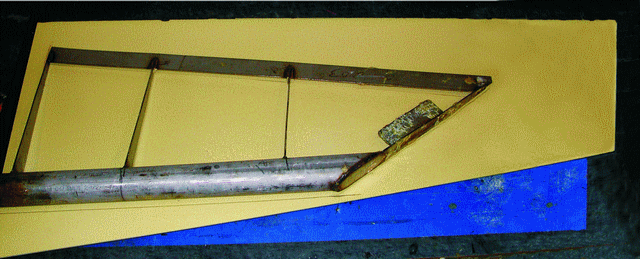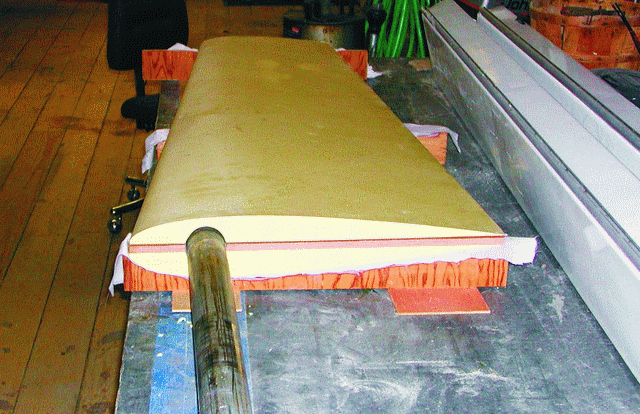
by Barry Duke
Above: The two foam halves of the rebuilt rudder, with the plywood core, are dry fit around the post before bonding.
What started out to be a relatively easy job of replacing the motor mounts and cutlass bearing on my 1983 Nelson/Marek 36 turned into building a completely new rudder. Once I removed the rudder, I had planned on fairing it and applying a WEST SYSTEM® Epoxy with 422 Barrier Coat Additive. barrier coat. However, upon closer inspection, I noticed that the rudder appeared to be bent.
At one of our Saginaw Bay Community Sailing Association work nights, Joe Parker and other board members agreed, and we began to look for some evidence of a past impact causing the bend. None could be found.

Plan A—repair the rudder
Our first plan to fix the rudder was to cut the lower half off, reattach it on a straight plane, and then fair it. But once we cut into the rudder, we were able to see that the post and weldments were not in alignment or centered with the foam rudder. We also could see that the rudder post was not straight. From what we could determine, the post was slightly bent when it was placed in the rudder form; when injected with foam, this created a rudder blade that was not centered or aligned with the post.
My wife and I purchased the boat in 1994. Looking back, we realize that we always noticed that the boat sailed differently on opposite tacks. We just chalked this up to rig adjustment or sail trim, but always wondered about it. Now we know the cause.
Plan B—let’s start over and rebuild
Once I removed all of the old foam core, Joe was able to straighten the post. Then I had to decide whether to build a blade from wood or go with foam. I chose foam but then had to decide whether to shape it by hand or use technology. Joe did some searching and found North End Composites on the East Coast with the ability to CNC-machine cut a perfect foil shape in two halves. So I took measurements to determine the proper foil shape and referred to Theory of Wing Sections by Abbot and Doenhoff to create the table of offsets necessary to machine the foam blade halves. I placed the order and soon had a perfect foil ready to be epoxied to the post.
Before working on and handling the foam foils, I applied a layer of 6 oz fiberglass fabric with WEST SYSTEM Epoxy to protect the relatively soft foam. The next step was to trace the surfaces that needed to be removed to allow for the post and weldments. I used a router with a ” straight bit to quickly remove the foam and did the shaping for the 2″ diameter post with some adhesive back sandpaper attached to a jar with a slightly larger diameter than the post. Because the 2″ diameter of the shaft was too wide for the foam rudder halves to be bonded directly to one another, I added a 6 mm plywood shim between the foam halves. The extra 6 mm allowed more room for the shaft weldment, and the extra thickness made the blade stiffer.
Now that the two halves fit around the post, it was time to epoxy them together. We used WEST SYSTEM 105 Resin® with 209 Extra Slow Hardener and 407 Low-Density Filler to create a thick putty and filled in all the gaps and covered all surfaces. Nylon strap band clamps and pieces of wood with various other clamps held the halves together as we watched the excess epoxy squeeze out. After the epoxy cured, I took the rebuilt rudder to my high school shop classes to give an impromptu lesson on applying two layers of 12 oz fiberglass fabric, overlapping at the leading edge. I finished the job by applying six coats of 105/206 with 422 Barrier Coat Additive.
My wife and I installed the new motor mounts, cutlass bearing, packing nut and aligned the engine and shaft. The marina lifted our boat so we could slide the rudder in place, and I finished by assembling the steering cables.
Did the rebuilt rudder make a difference? The first thing we noticed was that we were able to go half a knot faster at the same engine rpm. We also did not have to correct the steering as much, as the boat tracked much straighter. Under sail, we found that the tracking is much better, with less correcting and more feel from the sails to the rudder. There is also less turbulence (noise) from the rebuilt rudder. Sailing on either tack now seems to be the same. We finally figured out why.





